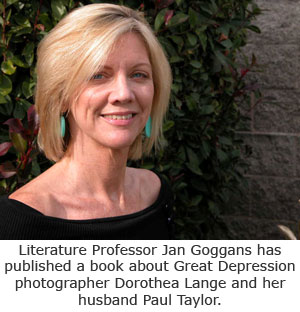


UC Merced
literatureProfessor
Jan Goggans’research into the iconic photographs shot by Dorothea Lange culminated this summer when the University of California Press published her book about the Great Depression’s impact on the state.
”
California on the Breadlines: Dorothea Lange, Paul Taylor and the Making of a New Deal Narrative” combines historical contextualization, biography and delves into some of the big issues of the time, water and agriculture. The book is an example of the university’s contribution to better understanding a part of nation’s history and culture.
Lange’s photos, depicting the plight of migrant workers in California, are a form of protest literature and can be read in the same sort of way as text, Goggans explained.
“The book tells the story of how this man and this woman met, fell madly in love over the fact that they shared ethical and spiritual values about what should happen to the oppressed migrant works of this state and the beautiful book they produced as a result of that,” she said.
Lange, a trained photographer, worked for the federal government to chronicle the Great Depression. Taylor, a labor economist with UC Berkeley, went on the road with Lange to collaborate on a book. In 1939, “American Exodus: A Record of Human Erosion” was published.
For Goggans, the Great Depression has both a personal and academic angle. Her father moved from Texas to California in 1932 at the age of six to live with his grandmother. She is always moved by the strength and determination of people during troubled times — both then and now in the midst of the Great Recession.
Her book has been well received with several endorsements from other scholars on the time period.
“With prose that’s as insightful as Taylor’s own and as vivid as a Lange photograph, ‘California on the Breadlines’ both captures and contextualizes this hugely important period,” wrote Rick Wartzman, author of “Obscene in the Extreme: The Burning and Banning of John Steinbeck’s ‘The Grapes of Wrath.’” “Goggans’ book will surely find its own place in the canon of Californiana.”
Goggans is already at work on her next project, which will look at the troubled notion of class, social status and economics in the Great Depression as it factors into film and literature.
One of the photos in Goggans’ book reflects this tension. The picture is of a migrant woman who is dressed plainly, but is still striking a post like Joan Crawford, a famous Hollywood actress. The woman, like other rural migrants seemed unaware of the barrier that would prevent her from passing into the world of movie stars.
“This fascinated me because class is a very shaky thing during the Great Depression,” she said. “If you’re standing in a breadline and you don’t know the economic status of the person next to you, what that means generally, is it’s a free for all in terms of the way you want to represent yourself. If you can pass for being rich, then people will think you’re rich.”






